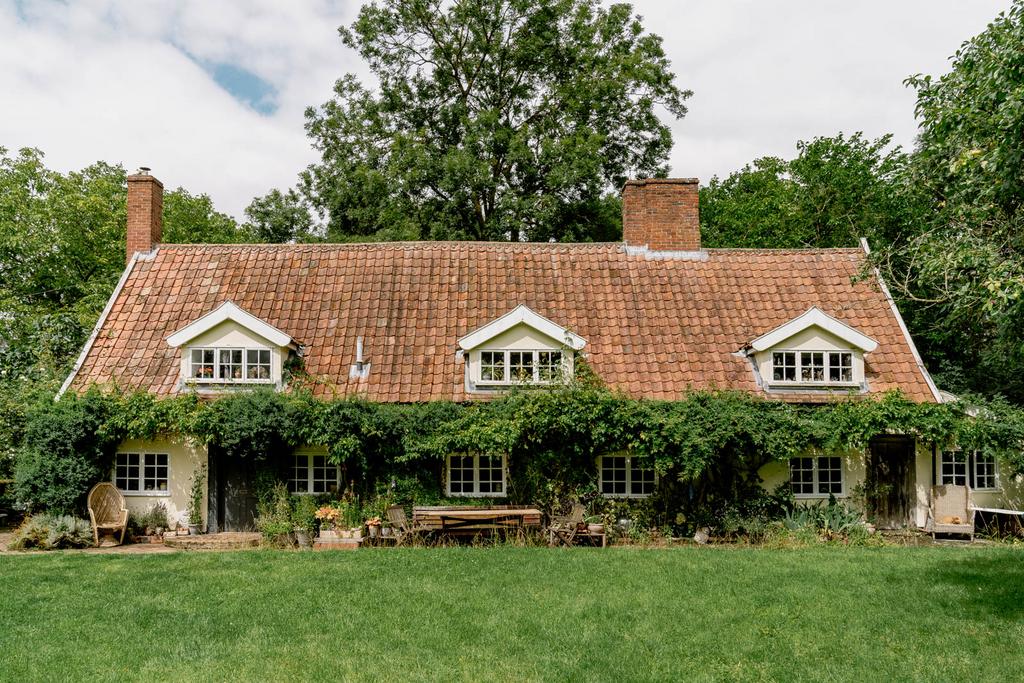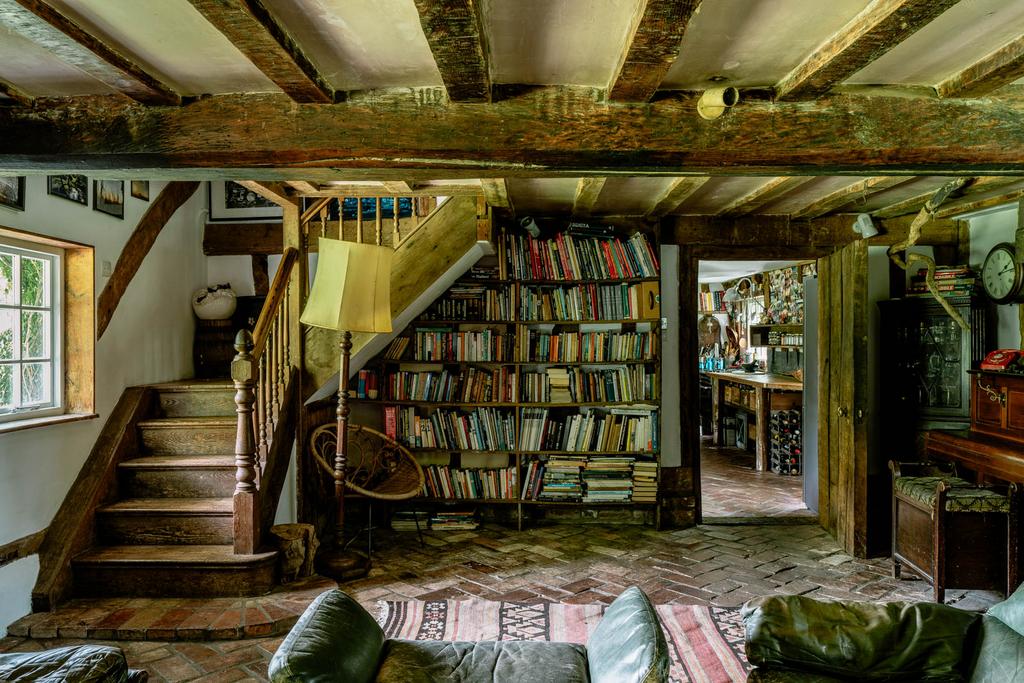This property is no longer on the market



4 bedroom detached house
Key information
Property description & features
- Tenure: Freehold
Setting the Scene
Turning down a blink-and-you-miss-it track, the countryside quickly envelopes the senses with a pervading quiet, muting modernity and letting wildness creep in. The track is a relatively modern convenience that Deakin got permission to build from the Reeve of the Common in the 1970s, after he purchased the 16th century house in near-derelict condition. The idea of restoring a house in the depths of Suffolk was borne out of Deakin’s long affinity with the region and a growing interest in reestablishing connection with nature and older, more traditional ways of living. Exploring the lanes and byways in a sky blue Morgan convertible (more at place in Fitzgerald’s Gatsby than muddy tracks of East Anglia) Deakin discovered the house in late 1969. Covered in tin, mouldering thatch and patchy lime plaster, the house had not been inhabited in several decades. Indeed, its previous tenants had been pigs and chickens! Deakin was smitten, and by September 1970, he was the owner of the farm.
A whirlwind of restoration and learning of new crafts ensued, but by the mid 1970s Deakin’s home was complete. The current owners spent much time at the house as children and have been the careful stewards of Walnut Tree’s heritage. For more information, please see the History section.
The Grand Tour
The house is set among a coppice of trees and 12 acres of natural meadow, hedgerow and woodland. The area is interspersed with outbuildings, including a railway carriage, cabin, and a large A-fame barn sheltering Deakin’s tractor, with workshop space above.
The building is clad in a light, straw-yellow ochre stucco with casement windows picked out in white; dormer windows emphasised by white barge boards are tucked under terracotta pantiles. Entering to the rear of the plan, a large country kitchen opens out. With brick floor underfoot, there is space for a large dining table and even an ample sofa. With a dark green Aga ticking away, the space is the perfect retreat on colder days or for reviving after a wild swim in the spring-fed moat. With the door thrown open to the lawn outside, the kitchen is perfectly placed for luncheons all summer long. Flowing onto the main sitting room in the heart of the house, an immense inglenook fireplace centres the room. The room is lined with bookshelves, and thickset beams run overhead. A downstairs bedroom with en suite and separate entrance is contained alongside the sitting room, creating an ideal guest suite. As well as a charming built-in bath inside, there is an additional outdoor roll top bath immediately outside this second entrance. The bath is the perfect place to unwind to pastoral views after an evening swim.
Upstairs, a further two bedrooms, dressing room and family bathroom are arranged around a central corridor. The large bedroom is expansive in proportions and is bisected by a huge 16th century chimney stack, making a dramatic feature of the period element, and creating a secondary space currently used as an artist studio by the current owners.
Outside there are three further spaces for living. A railway wagon was rescued and installed at the farm in the 1980s. It has been used as guest accommodation by the current owners, hosting many “Deakinites” on pilgrimage and featured in the Guardian. An outhouse is located a few steps away. The cabin is on the other side of the house and takes in incredible views of the long field stretching to what almost seems the horizon. There is also a shepherd's hut where Deakin often decamped to write and avoid the permanence of a house which he thought hindered his best inspiration. The interiors here have been lovingly preserved in original form and feature.
The Great Outdoors
Green to almost the very door, the land and gardens surrounding Walnut Tree Farm have been carefully preserved and gently tended to since Deakin’s arrival in the 1970s. Mature borders spring up around the house with nodding globe thistle and silvery yarrow attracting throngs of pollinators. Jasmine, bushy and thriving on the south facing side of the house, cloaks it in almost solid green with its riotous scent pervading the whole garden when in bloom. Roses, lavender and creeper intertwine charmingly.
An apple tree planted within a few steps of the kitchen door is the perfect place for garden chairs to be sheltered in its dappled shade. A kitchen garden with vegetables, herbs and soft fruit is nearby with a shed/wood store. The famous moat lies beyond; dredged by Deakin, the moat was kept weed-free for a time by regular sessions of one-armed weed pulling during swims. The farm's original walnut trees were added to by Deakin, planting scores of the Kyrgyzstan variety known for its enormous fruit and aromatic leaves. Meadow fields spread out around the house bordered by ancient footpaths. A coppice planted by Deakin is furthest from the house with many of the trees shaped and trained whimsically.
A large A-frame barn is clad in dark timber. This building shelters the Fordson Major tractor purchased by Deakin in the 1980s, which is still in use today. There is also space for a large workshop on the ground floor as well as ample storage for a number of gardening and farming implements. A room above is accessed by exterior stairs with a further floor in the apex of the A-frame up a ladder stair inside. Used as studio space at the moment, it could be converted for a number of other uses subject to planning.
Out and About
The village of Mellis, near the market town of Eye, sits on Suffolk’s northern edge bordering Norfolk along the River Waveney.
Mellis is centred around the largest grazing common in the UK; it is difficult not to be taken aback by the common’s sheer scale and prettiness. The glorious open space is fantastically flower-rich, grazed by cattle and horses in summer, framed by old, moated farm buildings, railway cottages and a few newer developments with an area for football in the centre. The common has remained relatively unchanged for hundreds of years, affording a glimpse of what large parts of the county used to look like – the Hodgkinson’s 1783 map of Suffolk depicts an outline of the common that is entirely recognisable.
The common’s importance to the rural landscape is recognised by its designations as a Conservation Area, a Special Landscape Area and a County Wildlife Site. Wildlife rich ponds and wet depressions pockmark the land where the clay has been quarried for building since medieval times. In summer rare plants such as green-winged orchid, sulphur clover and adder’s tongue fern flourish. An abundance of small mammals also makes the site a favourite hunting ground for barn owl, tawny owl and kestrel.
Cowpasture Lane, beloved and protected from agricultural encroachment by Deakin, runs alongside the land, taking you to Thornham Hall and its grand gardens in less than 3 miles. Originally a drovers’ lane, or ‘long green’ dating back to the Middle Ages, it was an important link between local markets. Of note are the villages of Fressingfield, Laxfield, Dennington, Worlingworth, Earl Soham, Debenham and the market town of Eye with its regular farmer’s market, butchers, bakery, and an array of fantastic antique stores.
Slightly further afield, the Suffolk coast is noted both for its beauty and, increasingly, its cultural attractions, including the towns of Snape Maltings, Aldeburgh, Southwold and Walberswick, which are all around one hour’s drive away.
There are several well-regarded schools in the area, including the excellent Mellis Primary School and the Ofsted-rated Outstanding Hartismere high school.
Despite its rural location, transport connections are very good, with Diss train station a 10-minute drive away providing direct links to London Liverpool Street in 90 minutes, or a two-hour drive direct to central London. It is also under an hour by car to the larger towns of Norwich, Bury St Edmunds and Ipswich.
Council Tax Band: F
Places of interest
See more properties like this:
*DISCLAIMER
Property reference TMH00484. The information displayed about this property comprises a property advertisement. OnTheMarket.com makes no warranty as to the accuracy or completeness of the advertisement or any linked or associated information, and OnTheMarket.com has no control over the content provided by the agent or developer. This property advertisement does not constitute property particulars. The information is provided and maintained by Inigo - London.
OnTheMarket may have applied supplementary data to this property listing, including:
Broadband availability and predicted speed: obtained from Ofcom on August 22, 2023
Broadband speed is measured in megabits per second, with the number returned showing how fast the connection is. Each reading is based on the highest predicted speed of any major broadband network for services that deliver the download speeds. The following are the different readings that we may display:
Basic: Up to 30 Mbit/s
Super-fast: Between 30 Mbit/s and 300 Mbit/s
Ultra-fast: Over 300 Mbit/s
The data is updated three times a year. The checker results are predictions and should not be regarded as guaranteed. For more information, see: https://checker.ofcom.org.uk/en-gb/about-checker#Answer_0_2
Mobile phone signal availability and predicted strength: obtained from Ofcom on August 22, 2023
Mobile signal predictions are provided by the four UK mobile network operators: EE, O2, Three and Vodafone. Predictions can vary significantly from the coverage you may actually experience as a result of local factors (especially terrain). Ofcom has tested the actual coverage provided in various locations around the UK to help ensure that these predictions are reasonable. The values shown against a property can be broken down as follows:
Clear: No bars, no signal predicted
Red: One bar, reliable signal unlikely
Amber: Two bars, may experience problems with connectivity
Green: Three bars, likely to have good coverage and receive a data rate to support basic web services
Enhanced: Full bars, likely to have good coverage indoors and to receive an enhanced data rate to support multimedia services
Energy Performance data and Internal floor area: obtained on August 22, 2023 from The Energy Performance of Buildings (Certificates and Inspections) (England and Wales) Regulations 2007 or the Home Report if in relation to a residential property in Scotland.
Any supplementary data should not be relied upon as forming part of any property particulars and OnTheMarket cannot be held responsible for any incorrectness in this data. See here for more information.
